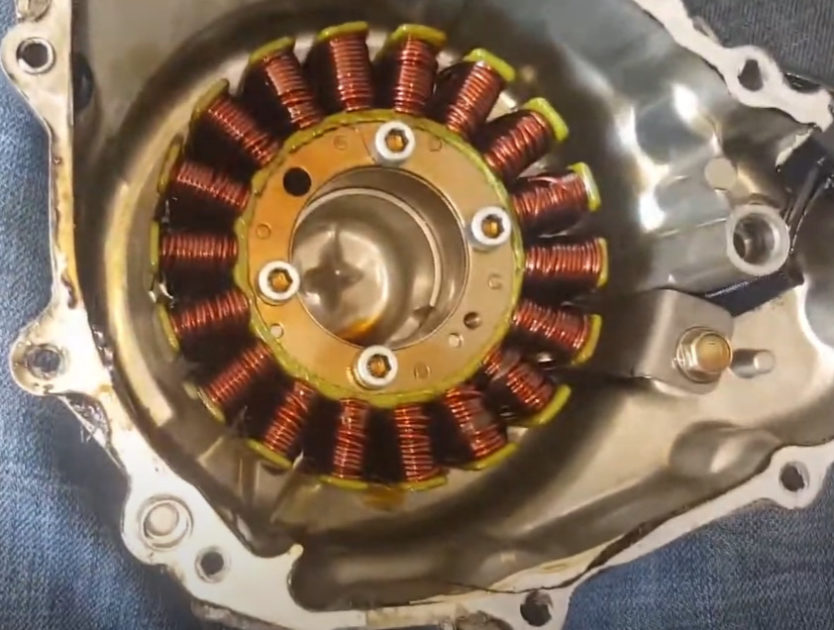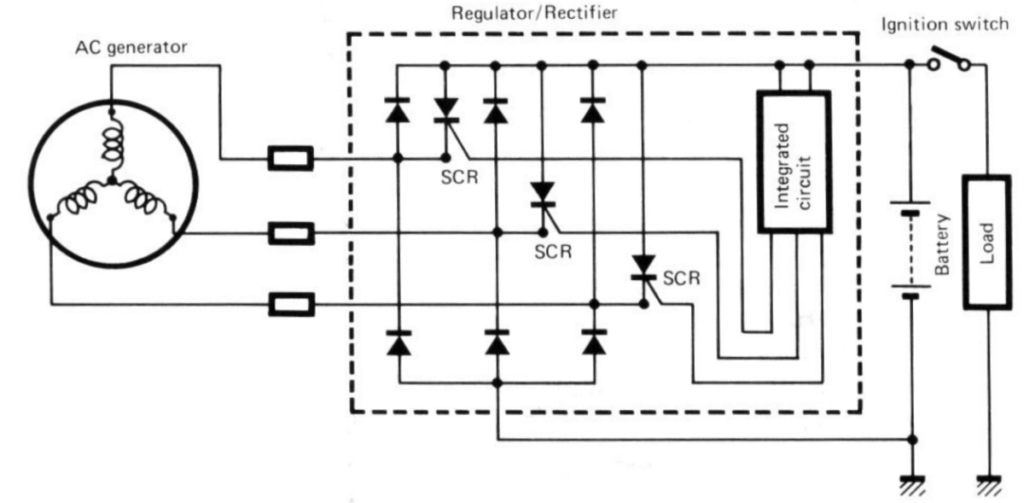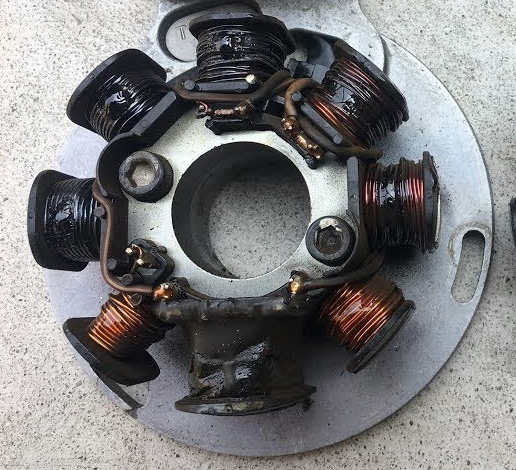Working on motorcycle charging systems can be quite a daunting task, especially if you’re unfamiliar with electronics.
However, most motorcycle charging systems are pretty simple and look more complicated than they actually are. You can certainly get the basics down in under 15 minutes.
If you’re unsure of what does a stator do on a motorcycle, then you’ve stumbled on to the right article! We will quickly explain what does a stator do on a motorcycle, what causes a stator to go bad, how to test a stator, replace it, and more.
Let’s get started.
What Does a Stator Do on a Motorcycle?
In a nutshell, the stator outputs electrical current inside the generator.

The stator is very easy to identify because it has lots of copper windings going around it.
As the name suggests, the stator is the stationary part of the motorcycle’s AC generator, while the rotor is the one that rotates around the stator. When the rotor is rotating around the stator, it induces electrical current into the copper windings of the stator and produces an electrical charge that’s used to power the motorcycle and charge the battery.
If the stator goes bad, your motorcycle will have trouble charging the battery and might have no spark (if it has an AC-powered CDI). Usually, the stator will go bad gradually by outputting lower voltage over a period of time.
How Motorcycle Charging Systems Work
Before we go any further, it’s important to get a quick overview of how the charging system works on a motorcycle. Just in case something else is causing the problem and not the stator.

As you can see from the image above, the motorcycle’s charging system consists of a 3-phase AC generator, regulator/rectifier, battery, and ignition switch.
This is the most basic charging system and you’ll find it on most motorcycles. There are different designs and additional components with them, but that is beyond the scope of this article. This is just a brief overlook.
So, how does the permanent magnet charging system work?
We’ve already talked about the rotor and the stator. That’s essentially what the generator is. The crankshaft spins the rotor and the magnets inside the rotor induce electrical current inside the copper windings of the stator.
Now, the problem with the 3-phase AC generator is that the output from the stator is >70 VAC (Volts Alternating Current), but the motorcycle needs ~14.5 VDC (Volts Direct Current) to run. That’s exactly where the regulator/rectifier comes to the rescue.
The raw 70 VAC from the stator goes into the regulator/rectifier box. Inside the box, a full bridge diode rectifier converts the Alternating Current to Direct Current. At this point, we have 70 VDC – still not the 14.5 VDC that our motorcycle needs.
Lastly, the 70 VDC passes through the Voltage Regulator. The voltage regulator lowers the voltage to 14.5 VDC and keeps it at a safe range of 13.5-15.5 VDC (depending on the model) no matter if the engine is idling or you’re hitting the rev limiter. At this point, we have safely converted the unusable 70 VAC to the 14.5 VDC that the motorcycle needs.
That’s how the permanent magnet charging system works on a motorcycle, in a very basic sense.
Motorcycle Stator Test
If you suspect that your motorcycle’s stator is bad, then you can quickly and easily test it for faults using the following methods. Furthermore, if you can get your hands on a service manual for your motorcycle, then you would be much better off as the manual contains the proper testing procedure for the stator, with the right specs and everything else.
1. Motorcycle Stator Short to Ground Test
First, locate the stator wiring harness, which usually consists of three wires. The best way to do that is by looking for the wires coming out of the generator cover.
Once you’ve located the three-wire stator harness, follow the wires to the connector and disconnect it. It will likely be located under the seat.
Turn on your multimeter and select the continuity mode (the Ω symbol).
Take the stator side of the harness and check for continuity to ground for each of the three wires. To do that, touch one lead of the multimeter to battery negative (-) or any bare metal part of the motorcycle, and the other lead to each of the wire terminals. Make sure to only lightly touch the connector terminals.
There should be no continuity to ground. If there is, then your stator is shorting out to ground and needs to be replaced.
2. Motorcycle Stator No Load Performance Test
One of the best ways to tell if the stator is bad, is to disconnect it and check its output voltage while the engine is running.
Since the stator harness plug is already disconnected, you can go ahead and start the engine.
Now, set your multimeter to VAC (the V~ symbol) and measure the motorcycle stator output voltage while the engine is running. Touch one lead to one of the terminals and the other lead to the terminal on the same connector. Make sure to test all three combinations. Total of three measurements.
Motorcycle stator output voltage should be >70 VAC at cruising RPM. This can be different depending on the model, so consult your motorcycle’s service manual if possible. Also, make sure that the voltage is roughly the same on all three terminals.
If the motorcycle stator output voltage is below 70 VAC at cruising RPM, or one of the terminals is producing significantly lower voltage, then the stator is bad and needs to be replaced.
What Causes a Stator to go Bad?
A motorcycle stator is simply a piece of iron with copper windings around it – there’s not much that could go wrong. However, stators do go bad sometimes, but mostly due to other components that have gone bad.
The stator can go bad due to overloading, bad rectifier/regulator, or corrosion.
1. Overloading The Stator
The copper windings on the stator are insulated with a layer of clear insulating coat. It’s crucial for the coating to keep the wires from shorting out, otherwise, the stator will burn out and fail.

But, if your battery has gone bad and is requiring a lot of electrical current to charge, or you have added additional electrical accessories for your bike, then the poor stator will have to work extra hard to produce more electrical current.
If the issue goes unnoticed for a long time, the stator will eventually overheat and short out once the insulating coat melts from the heat. Because of that, it’s always a good idea to check the condition of your battery regularly.
2. Bad Rectifier/Regulator
Another common reason for a bad stator is a failed rectifier/regulator.
The rectifier/regulator is tasked with converting the high voltage alternating current from the stator into 14.5 Volts Direct Current. If the rectifier portion of the rectifier/regulator box fails, then it starts to dump alternating current back to the stator.
The extra AC current will make the stator heat up and eventually melt.
3. Corrosion
This one is not that common but still happens from time to time.
If the electrical connections from the stator to the battery are corroded, then the stator will have to work harder to push electrical current through them.
Will a Bad Stator Cause no Spark?
Yes, a bad stator can cause a no spark condition if your stator contains exciter/source coils for the ignition system. On some systems, one or a bunch of coils are used for powering the ignition system, while the rest are used for charging.
If the exciter coil is shorted to ground, then the coils won’t send power to the CDI and you will get a no spark condition.
Final Thoughts
Hopefully, now you know what does a stator do on a motorcycle.
The stator is the one that provides electrical current to your motorcycle, while the rotor induced current into the stator.
While the stator is extremely simple, being just a piece of iron with copper windings around, it can cause a no spark condition and prevent your motorcycle from starting.
Jake is the site’s primary contributor.
Motorcycles and automotive repair have been a big part of his family for generations, therefore it’s only natural that he decided to become a heavy-duty diesel tech.
Outside of work, you’ll find Jake restoring and riding rare street bikes and ATVs.